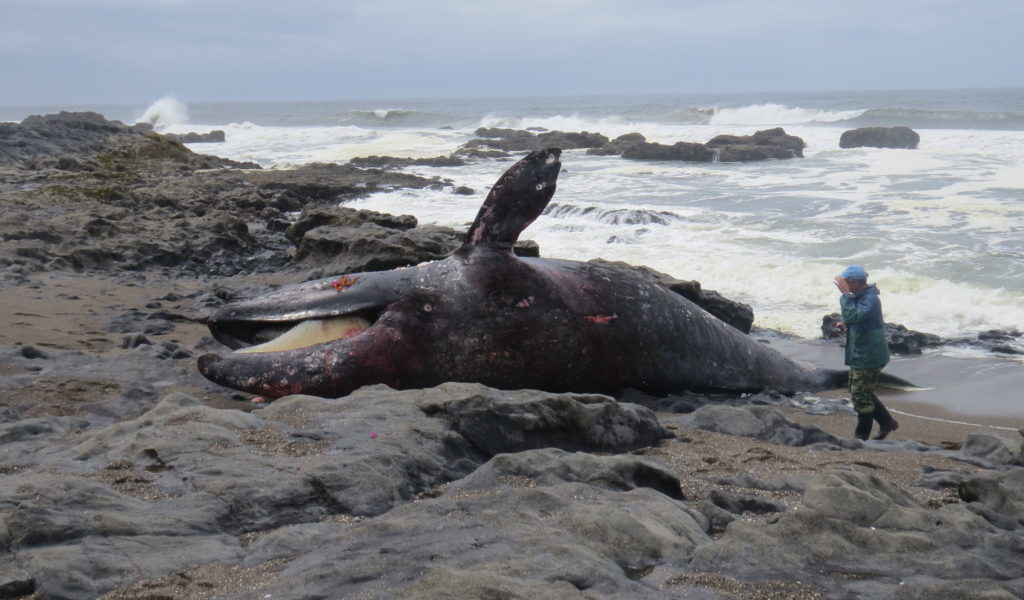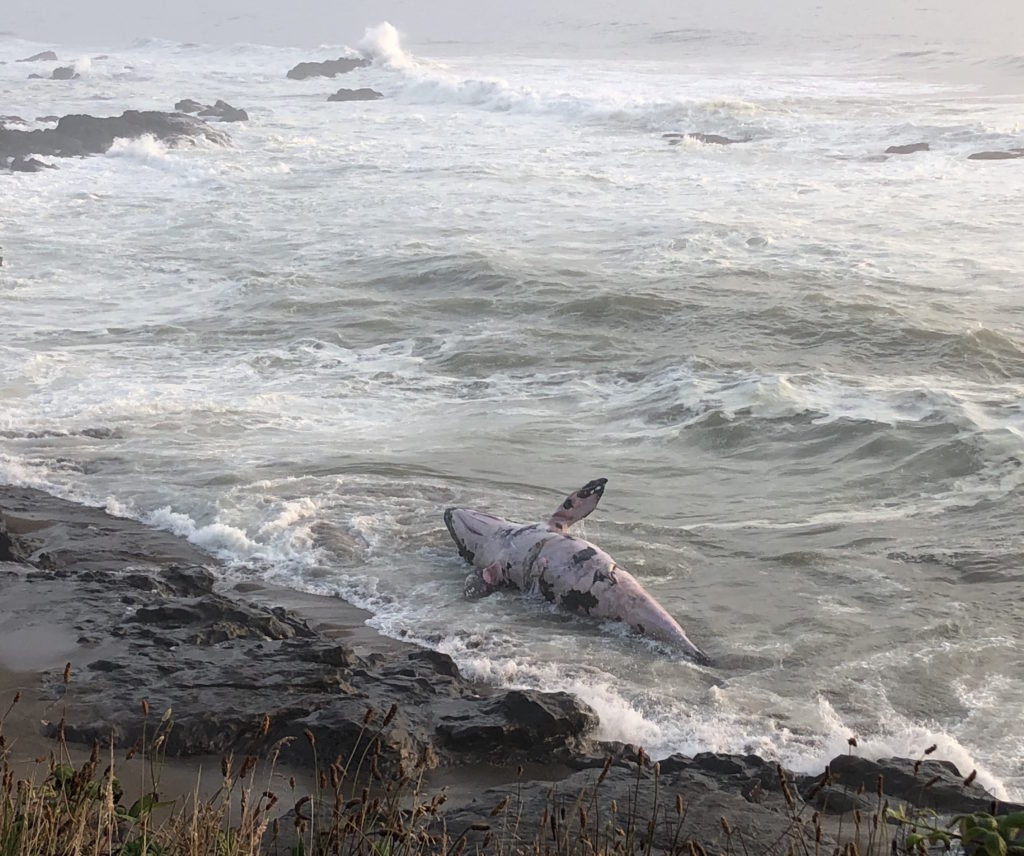
By QUINTON SMITH/YachatsNews.com
A young gray whale on the beach in Yachats was likely dead when it washed ashore Monday and could have been killed by orcas that prey on juveniles.
Jim Rice, head of the Oregon Marine Mammal Stranding Network at the OSU Marine Mammal Institute in Newport, took measurements and tissue samples of the whale Tuesday so scientists can try to determine how healthy it was and if anything other than predation led to its death.

The young 30-foot-long male – most likely born this year – had evidence of orca teeth marks on top of its head, back and near its tail, Rice told YachatsNews as he let air out of the bloated body and took tissue samples.
Orcas prey on young whales and use their numbers to drown the larger mammal, said Rice and stranding network volunteer Jane Holbrook, while the whale’s mother tries to keep it on the surface.
“There’s some signs of predation,” Rice said. “They may have held it under water to prevent it from breathing.”
Young whales are more susceptible to predation by orcas until they get larger and stronger, he said.
Scientists will study the tissue samples to determine hormone levels and other chemical factors that can help determine if the animal was under stress and how healthy it was. That data will also be used in a West Coast gray whale mortality study being conducted by the National Oceanic and Atmospheric Administration.
Rice said it is just the third gray whale that has beached this year in Oregon, which is about normal.

Spotted Monday morning
The whale was near death or already dead and just floating with the current or with other whales when Yachats residents first spotted it Monday morning off Yachats State Park.
It first lodged in a rocky cove below West Sixth Street but later during high tide floated south and onto a sand and rock beach where it could be accessed during low tide Tuesday.

Crowds of Yachats residents and visitors stopped along the bluff Monday and Tuesday to view the scene below. Sometime after the whale beached Monday night, someone put a spray of flowers on its head.
Yachats resident Adam Altson, who lives on West Sixth Street, and visitors saw the whale offshore Monday morning near Yachats State Park and floating slowly north – either dead or moving with the current. It was with a pod of other whales, said Jim Foster of Boise, who is staying at a beachfront house nearby.
“We saw it wash in and the pod took off after that,” Foster said.
Holbrook got to the adjacent rocks Monday afternoon but was unable to get close enough to see if it had been injured. It had only a few barnacles.
“It hadn’t been out there long,” Holbrook said. “It’s a beautiful animal … but there is a mortality out there. Nature can be tough.”

Gray whales mostly healthy
The Oregon portion of the West Coast network is based at Oregon State University’s Hatfield Marine Science Center in Newport. In addition to helping live, stranded mammals, it takes information on dead animals that wash ashore to put into a national database for researchers.
Whale populations along the West Coast have recovered well in the past 30-40 years. Gray whales are most commonly seen off the Oregon coast, migrating north to Alaska waters in the spring or south to calve off the coast of Mexico in the fall.
Oregon is known for having a small population of “resident” gray whales that appears to live off the Pacific Northwest coast in the summer and fall – and not taking the long migration north to the frigid but rich feeding grounds of the Arctic Ocean.
While thousands of gray whales migrant north past Oregon in the spring and south in the late fall, few dead whales wash ashore. Holbrook said a gray whale washed ashore this spring north of Lincoln City. This is the first gray whale to have washed ashore in a public area of south Lincoln County since a juvenile humpback whale stranded itself exactly two years ago on the sandy beach at Bayshore just north of Waldport and had to be euthanized after 30 hours of attempts to save it.

Real view of nature’s work
The beached whale may present some problems – and daily views of nature’s processes — to residents and visitors along Ocean View Drive.
Oregon State Parks and Recreation is responsible for disposal – if possible – for disposing or burying whales once they wash onto beaches.
But there is not enough sand where the whale was beached Tuesday afternoon, there is no way to get equipment down there, and summer tides may not be strong enough to move it out of the rocky cove.
“You may be smelling it for awhile,” Holbrook said.
But Tuesday night, the high tide about 7:45 p.m. moved the whale from the beach where it was earlier in the day to a bit farther south, banging against the rocks and sand, rolling in the surf and stripping the skin from its body. It was not a pleasant sight.
“It’s sad,” said one of the many people watching from the cliff above. “It makes me sad.”





It was a rather sad sight to see. This was definitely a very young whale with its dearth of barnacles. Thankfully all the folks we saw at the site were respectful. There was another whale right offshore about 200 yards that was constantly spouting and breaching, possibly this young whale’s mother or partner. It does seem a bit early for the trip down to Baja but anything is possible. RIP young fellow!